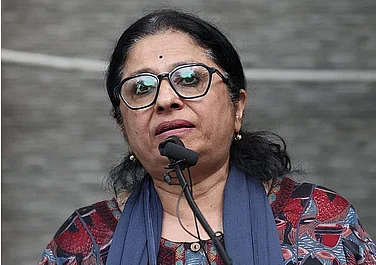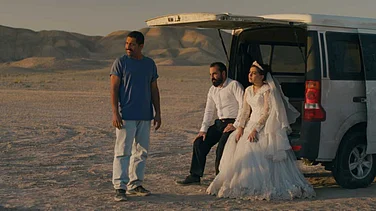Released in 2019, Gamak Ghar is a cinematic exploration of familial ties, memories and the architectural language of an ancestral house in Bihar’s Maithili-speaking Darbhanga region. The film is a portrait of a large extended Indian family over several decades as they gather at their matriarch’s rural home, following the inevitable rhythms of change, children moving away to the city and the inevitable decay of traditional village life.
***
There is a lone tree. A few floating clouds. A serpentine road and then the house is revealed. The house is a spectacle that is both mute and articulate. A kitchen, a courtyard, windows, rooms, and the entrance. The screen is a landscape of desire, of nostalgia, and of loss. It is a portal.
A single ray of sunshine, that breaks through the old window bars and falls on the floor in the frame, is enough to take me where I have not been in years, to make me see that house again, to feel the loss, to be in that house once more.
Cinema has that power. To take us where we haven’t been, the promise of a house. In watching a film, we gaze at a space we can never occupy but can live in or have lived in. In Achal Mishra’s Gamak Ghar, which was released in 2019, the house is the protagonist. The house hasn’t been scanned and it is here that we experience the tenuousness of property relations and through it, the story of migration, of aspiration, and of loss.
The film is set in Mishra’s ancestral village, Madhopur, in Darbhanga and is about the house that his grandfather built in the 1950s. A structure becomes home with presence and this real, lived-in space was where fiction intersected with the real and then, with my own story.
It is real and, in its realness, it contains a thousand other such homes. Like memory, which can’t be created. It is both real and surreal. The house inspires, it acts and it disintegrates. I wonder if the house would be the same if it were made up of footage and insertions. Would I then enter it the way I did?
In one of the scenes in the film, the grandson is looking for his dead grandfather in the belongings that the latter has left behind. There is a diary with minute details of all expenditures, photo albums and drama books, all tied up in a red piece of cloth and stored in a big aluminium sandook (chest) by the grandmother. That sandook is ubiquitous. Objects are triggers. That’s realness.
I watched the grandson in the film shuffle through the photo album and felt that perhaps we could have gone back, broken the locks of our old house in Pipra in Khagaria, Bihar, and seen some of the old furniture lying there still. Like my grandparents’ bed or the circular table in the veranda where I would sit in the company of my grandfather and his friends during my visits.

Gamak Ghar is a personal testimony, an ode to a house that has been abandoned. But like an old woman who waits for a final reunion, it waits until it can’t anymore and becomes a fixture in memory. The film is a memory piece about families and migration and the house is the setting and the protagonist. It speaks for many such houses. Like mine that we left behind. In the film, the family of three brothers, a sister and a widowed mother have all migrated to different cities. They visit their village home only occasionally now. Either to celebrate or to mourn. Like we did.
There is the language too. The Maithili language film represents the people of Mithila. It is the language that I grew up with. The language I spoke to my mother in.
It is in the abandonment of the house in the film that I feel the magnitude of a collective loss. A decade ago, when I visited Pipra, my village, my ancestral house looked abandoned. Like any other abandoned house from the past. Uninhabited and unkempt, home to wild grass, vegetation and bats. The abandonment was recent though. The roof and the walls of the house were still intact then. So were the grills, the doors and the window frames like the memories. Memories of four generations, including that of my great-grandmother and brother, who had lived under its roof.
It was a very brief visit that lasted less than two hours. We only crossed the house then. That abandoned house that was once a home. I could only steal a glance. It was locked. It was nothing like the home of our childhood. But I guess that is true for all abandoned houses. They can never resemble the living homes of your childhood.
It was the house that also contained my language, which is Maithili.
Gamak Ghar represents the architecture that many houses in the region carry from that era. There would be a veranda in the front and a courtyard at the back. Men would occupy the veranda and women would use the courtyard. The veranda, like in the film, had big pillars and it opened to an empty space in the front, which then led to the main village road.
What is a home? It is perhaps a silent witness to the lives lived and memories created behind its thick walls. Gamak Ghar is that. A storehouse of memories.
You return to the house via the film. I might not be as lucky as the grandson in the movie who found the diaries and the albums. All my grandfather’s books, diaries and letters would probably have been lost to termites or time itself.
In the absence of anything tangible, a film becomes a reflection of a landscape. The celluloid space is full of potential where real sites are found within the narrative and offer spatial reconnection. A lived space is a continuum.
Watching Gamak Ghar was like watching our own lives on celluloid and probably that of every family that migrates, leaving behind a home and years of collective memories.
Unlike the grandson in the movie who rebuilds the house to keep it ready in time for his son’s thread ceremony, I doubt my brother or I would go and rebuild our village home. Unlike the grandson in the movie, who has migrated to a nearby city in the same region, I seem to be a perpetual migrant, traversing across the length and breadth of the country. Every shift further weakening the link to that home.
Perhaps in the future, someone will come to live there. They will make their own home, create their own memories and make their own ‘Gamak Ghar’.
Gamak Ghar, the film, is a tangible reflector, an imaginative prism where imagination is activated and all filmmaking is also about shifting that material existence into a mental reality. The village home is an in-between place, a contested space and where the house is social space, a personal space. It is not a generic place, but a particular one. I strive to arrive there. There is that possibility in its realness.
Ashutosh Salil is an IAS officer

























